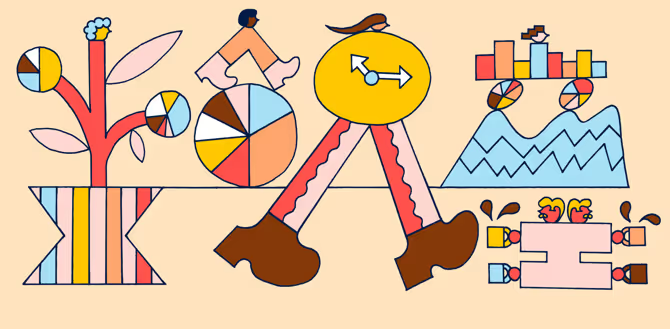How to set & communicate clear team expectations (with examples)

Discover Workleap Officevibe's benchmark report on 12 key employee engagement metrics

Imagine this. A carpenter is commissioned to build a very specific house for a client, but he isn’t given any plans or blueprints. This is a recipe for failure. Unfortunately, this is also what employees experience when leaders don’t provide them with clear team expectations.
According to a study from Gallup, only half of employees say they know what their workplace expectations are. And, according to our Officevibe software for managers,
Setting clear expectations is an essential management skill to build a culture of quality work and accountability. Uncertainty about roles and expectations leads to poor performance, high stress and turnover. That's why it's critical for managers to build the reflex of providing clear expectations for their team.
Different types of team expectations and why they’re important
Simply put: team expectations are what you anticipate and expect from your team. This can be in terms of quality of work, behaviours, and collaboration.
Expectations offer direction, create accountability and unite a team or company around a shared goal or objective. Lack of clarity around expectations is a fatal flaw in management. If people aren’t sure what to work on, you leave success up to chance, risking harming relationships along the way. Employees who don’t know whether they're on the right path can easily feel unmotivated and disengaged.
There are different categories of expectations, and each one is equally important for high performing teams.
Categories of team expectations:
- Team performance expectations are goals based on business objectives
- Individual performance expectations help employees develop
- Expectations for how people should behave with relation to team values
- Expectations regarding work quality, processes and methodology
- Expectations related to work hours, time off, meetings and tools
If any of these points are unclear, you'll run in to glitches. If, for instance, deadlines and key results are ill defined, the team is likely to miss deliverables. Alternatively, if norms around behaviour and values are not solidified, it can hinder collaboration. Consequently, employee engagement and performance risks decreasing. The most dangerous thing you can do as a leader is assume that what is clear in your head, is also clear to your team.
Examples of effective team expectations:
- Be on time for meetings
- Send a detailed agenda for all meeting invites
- Be accountable for your mistakes and share your learnings
- Take initiative to review important information before asking a question
- Work in increments and iterations to deliver value
- Be respectful and clear when giving feedback (top feedback examples for your team)
- Have a learners mindset: seek out feedback from your peers
- Be present during meetings; avoid checking Slack or your phone
- Prioritize the team’s success before your own
- Ask questions when something is not clear
- Raise flags when you see a blocker
- Seek to understand a point of view before challenging it
How to set clear team expectations
Below, we unpack some key ways to help you build the management skill of setting clear expectations. We also offer impactful tips to communicate clear goals and expectations.
Document your team's purpose and role
Remember that your team has a mandate. Treat the team as an employee of the organization and give it a job description Doing this helps define your team's general goal as it relates to greater business objectives. Write out a clear reporting structure for roles, tasks, and core duties. Give your team access to this so that they have a point of reference.
💡 Tip: Officevibe's one on one software provides you with space to clearly outline your team's goals. These then appear in each team member's account, acting as a guide for their own individual goals and helps them keep their North Stars front of mind.
Collaboratively outline team principles and values
Have your team reflect on a set of values to live by. Solidify behavioural expectations within the team to solidify cohesion.

“I think the best expectations are those that come from the team itself. Instead of just coming up with the expectations yourself and communicating them to the team, have team members take the leap and write down what they feel or think is expected of them.
Do the same exercise on your own, and then regroup with the team to share your perspectives. This process will help highlight similarities and differences, which fosters empathy, accountability and alignment!”
For example, a value our team agreed to was: “call out the elephant in the room”. This encourages employees to prioritize difficult conversations, and embrace the discomfort. It allows team mates to feel less conflict averse and look out for each others' best interest. Having this shared responsibility enables the team to perform with cohesion and connection.
Here's an example of team expectations during meetings:

Define your expectations around quality
It’s one thing to ask your team to deliver a project to a client, it’s another to outline your expectations and quality standards. If you aren’t clear about this, your team may need to redo the work to fit your vision. Work smart by explaining your expectations clearly from the inception.
💡 Tip: Establish and document guidelines for an “MVP” (most viable product). Establish non-negotiables that your team must meet before submitting work to a client? For example: a review checklist to avoid typos, and adhere to brand guidelines. When the team is on the same page, they've succeeded at collaborating to produce high quality of work.
Set clear milestones for goals with action items
To help teams work toward big projects, break them down into milestones and action items. A milestone is a mile-marker of progress, such as completing the draft of a design plan. An action item is a specific to-do item, such as getting another team’s feedback on the draft design or meeting to discuss next steps.

Use the Officevibe platform’s 1-on-1 tool to set clear goals and action items with each employee. Officevibe’s goals are based on the SMART model (Specific, Measurable, Attainable, Relevant and Time-bound). Once a goal is set, you can break it down into Action Items. During each 1-on-1, aim to simplify with a step-by-step process.
Sign up for Officevibe for free!
How to communicate your expectations effectively and intentionally
Use storytelling to make an impact
Employees are more likely to remember anecdotes than bullet points. When communicating in person, storytelling helps to contextualize your expectations. You can do this by illustrating what success looks like. Then, reinforce why it matters. A bigger picture helps your team learn about your perspective and expectations.
Ask your team to repeat what they heard
Double-check that employees have understood what you meant by asking them to repeat the expectations back to you. You can also encourage them to ask questions. This gives you the opportunity to clarify anything that got lost in translation before teams begin the project.
Review expectations frequently
In general, it's best to repeat your expectations often and in different ways, such as with written documentation and verbally. As things change on your team you want to reiterate your expectations within the new context. Be sure that all documents are easily accessible and written concisely.
💡 Tip: Officevibe helps you set expectations and clear goals with our Goal setting framework. After you’ve taken the time to set expectations both at the team level and on the individual level, work towards frequent and continuous alignment during 1-on-1 meetings. You can also use the Officevibe platform’s 1-on-1 tool to add Talking Points to your 1-on-1 meeting agendas!
When you communicate clear expectations, your team will work together on a shared goal. They'll feel motivated by clear responsibilities and deliverables. It may sound simple, but managing expectations properly is the easiest way to go from merely getting the work done to excelling.
Give HR and managers the clarity, confidence, and connection to lead better every day.


%20(1).avif)


.avif)
.avif)








